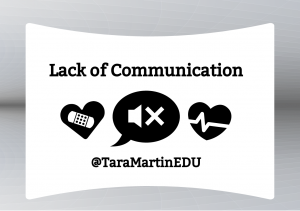I’m pretty convinced at the heart of most problems is a communication error. It might be a lack of communication, or misinterpretation of what was said, or perceived notions of a particular body language, etc. However, when you take a given problem (systemically or relationally) and trace it back to the root-cause, it’s typically miscommunication of some sort.
Interestingly, most problems, be it educationally or some other professional setting, are “solved” with technical solutions which many times only scratch the surface of the issue. The crazy part about this Band-Aid© approach solution is the actual surgical procedure would be so much easier and efficient to perform.

Condition: Lack of Communication
Band-Aid© Approach – Stay Silent
Day Surgery – A Little Goes a Long Way
Lack of communication is a doozie. Many times a little clarity goes a long way. I’ve found working at the district office, sometimes I don’t have ALL of the answers for the teachers and principals I serve; there are so many moving parts that I don’t have control over. However, rather than ignore them or make stuff up, I share the few FACTS I know to aid in some understanding. For example, I may not know the exact start date a web-based program will be updated with all of our students, but I might know some things about the process. Rather than waiting until I have a date, I might reply to the principals sharing all of the facts I currently know (even if it isn’t much). Something like, “It looks like the program is up and running in the IT department, but currently we do not have a projected start date of when our students will be entered in the system. I will let you all know when I have more details.”
Simple? Yes. Buys you time? Yes. Builds rapport? Most definitely.
The truth is, silence is often perceived as something far worse than the reality. Especially for those with extreme imaginations.

Condition: Misperception
Band-Aid© – Ignore It
Day Surgery – Powerful Paraphrasing
When dealing with misperception, I like to use the power of paraphrasing. Often, this simple strategy stops the problem before it ever begins. For example, when you’re in a meeting or a one-to-one conversation, and you feel uncertain about what was said or done, you might reply with a paraphrase such as, “I think I heard you say…” or, “When you said ___ and did ___, I perceived that to mean___.” Then, PAUSE and allow the speaker space to clarify. This seemingly insignificant strategy has saved me from making misperceptions of comments and/or body language many times when coaching teachers or working with leadership teams throughout the district. If this one is left unattended, it can become a mess. Let’s not settle for “tucking our thoughts away” and hoping everything works itself out.
As difficult as it might be to have these types of conversations, I firmly believe that if we don’t make clear communication intentional with our staff and school community, our problems will grow exponentially and the culture of the system, or relationships, will suffer irreversible damage.


